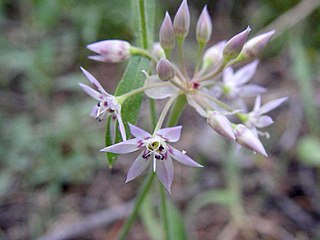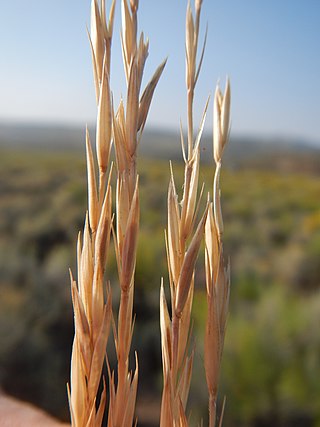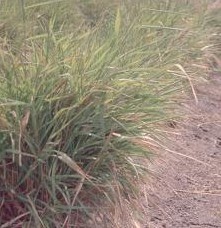
Ornamental grasses are grasses grown as ornamental plants. Ornamental grasses are popular in many colder hardiness zones for their resilience to cold temperatures and aesthetic value throughout fall and winter seasons.

Leymus is a genus of plants in the grass family Poaceae (Gramineae). It is widespread across Europe, Asia, and the Americas.

Holodiscus discolor, commonly known as ocean spray or oceanspray, creambush, or ironwood, is a shrub of western North America.

Arctostaphylos auriculata is an endangered species of Arctostaphylos endemic to California, and limited in geography to the area surrounding Mount Diablo, in Contra Costa County.

California oak woodland is a plant community found throughout the California chaparral and woodlands ecoregion of California in the United States and northwestern Baja California in Mexico. Oak woodland is widespread at lower elevations in coastal California; in interior valleys of the Coast Ranges, Transverse Ranges and Peninsular Ranges; and in a ring around the California Central Valley grasslands. The dominant trees are oaks, interspersed with other broadleaf and coniferous trees, with an understory of grasses, herbs, geophytes, and California native plants.

The Fairfield Osborn Preserve is a 450-acre nature reserve situated on the northwest flank of Sonoma Mountain in Sonoma County, California. There are eight plant communities within the property, oak woodland being the dominant type. Other communities include chaparral, Douglas fir woodland, native Bunch grass, freshwater marsh, vernal pool, pond and riparian woodland. The flora is extremely diverse including many native trees, shrubs, wildflowers, grasses, lichens and mosses. A diverse fauna inhabits this area including black-tailed deer, coyote, bobcat and an occasional mountain lion; moreover, there are abundant avifauna, amphibians, reptiles and insects.

Nassella pulchra, basionym Stipa pulchra, is a species of grass known by the common names purple needlegrass and purple tussockgrass. It is native to the U.S. state of California, where it occurs throughout the coastal hills, valleys, and mountain ranges, as well as the Sacramento Valley and parts of the Sierra Nevada foothills, and Baja California.

Allium campanulatum is a species of wild onion known by the common name dusky onion or Sierra onion. This is a flowering plant native to the western United States from southeastern Washington and northern Oregon to southern California, and western Nevada. The dusky onion grows in foothills and mountains, especially in dry areas, such as chaparral habitats.

Elymus elymoides is a species of wild rye known by the common name squirreltail. This grass is native to most of North America west of the Mississippi River and occurs in a number of ecosystems, from the alpine zone to desert sage scrub to valley grassland.

Tussock grasses or bunch grasses are a group of grass species in the family Poaceae. They usually grow as singular plants in clumps, tufts, hummocks, or bunches, rather than forming a sod or lawn, in meadows, grasslands, and prairies. As perennial plants, most species live more than one season. Tussock grasses are often found as forage in pastures and ornamental grasses in gardens.

Eriocoma coronata, formerly classified as Achnatherum coronatum, is a greenish species of grass known by the common name crested needlegrass, giant ricegrass, and giant stipa.

Eriocoma pinetorum is a species of grass known by the common names pinewoods needlegrass and pine needlegrass. It is native to most of the western United States from California to Montana to New Mexico, where it grows in woodland and forest in rocky mountainous areas.

Leymus cinereus is a species of wild rye known by the common names basin wild rye, Great Basin wild rye, and Great Basin lyme grass.

Leymus triticoides, with the common names creeping wild rye and beardless wild rye, is a species of wild rye. It is native to western North America from British Columbia to California and Texas.
Poa diaboli is a rare species of grass known by the common name Diablo Canyon bluegrass. It is endemic to San Luis Obispo County, California, where it is known from about five occurrences in the San Luis Mountains near the coast. The type specimen was collected in Montaña de Oro State Park and the grass was described as a new species in 2003. The grass occurs on rugged mountaintops and north-facing slopes in thin soils covering shale rock within a few kilometers of the coastline. Its habitat includes chaparral, oak woodland, coastal sage scrub, and Bishop pine forest.

Leymus salina is a species of grass known as Salina wildrye, Salina Pass wild rye, and saline wildrye. It is native to the western United States and is named for its type locality: Salina Pass, Utah.

Melica nitens is a species of grass known by the common names threeflower melicgrass or three-flowered melic. It is native to the central United States.

Leymus multicaulis, also known as manystem wild rye or manystem lyme grass, is a species of the genus Leymus. The species name of manystem wild rye, multicaulis, suggests the “many stems” of the species. Leymus multicaulis is considered a type of grass. Manystem wild rye has only one cotyledon in each of its seeds. The xylem and phloem within the roots are arranged in a ring pattern. The vascular bundles are scattered throughout the stem. These traits make Leymus multicaulis a monocot. Leymus multicaulis is a flowering plant, or angiosperm.

Leymus mollis is a species of grass known by the common names American dune grass, American dune wild-rye, sea lyme-grass, strand-wheat, and strand grass. Its Japanese name is hamaninniku. It is native to Asia, where it occurs in Japan, China, Korea, and Russia, and northern parts of North America, where it occurs across Canada and the northern United States, as well as Greenland. It can also be found in Iceland.


















